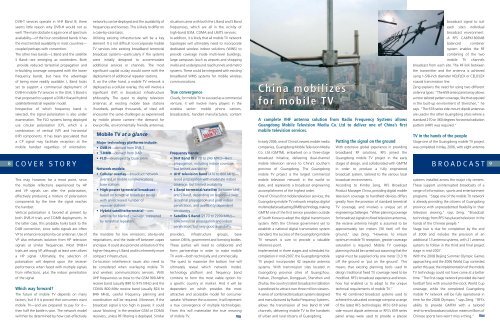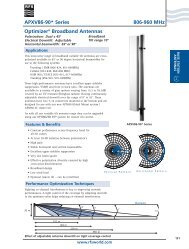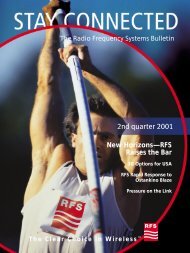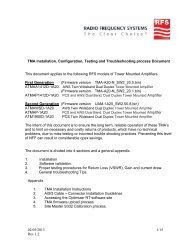Download - Radio Frequency Systems
Download - Radio Frequency Systems
Download - Radio Frequency Systems
Create successful ePaper yourself
Turn your PDF publications into a flip-book with our unique Google optimized e-Paper software.
DVB-T services operate in VHF Band III, there<br />
seems little reason why DVB-H would not as<br />
well. The main obstacle is again one of spectrum<br />
availability—of the four considered bands it has<br />
the most limited availability in most countries—<br />
coupled perhaps with convention.<br />
The other two bands—L Band and the satellite<br />
S Band—are emerging as contenders. Both<br />
provide reduced terrestrial propagation and<br />
in-building coverage compared with the lower<br />
frequency bands, but have the advantage<br />
of being more readily available. L Band looks<br />
set to support a commercial deployment of<br />
DVB-H mobile TV services in the USA; S Band is<br />
that proposed to support a DVB-H based hybrid<br />
satellite/terrestrial repeater model.<br />
Irrespective of which frequency band is<br />
selected, the signal polarization is also under<br />
examination. The FLO systems being deployed<br />
use circular polarization (CP), which is a<br />
combination of vertical (VP) and horizontal<br />
(HP) components. It has been speculated that<br />
a CP signal may facilitate reception at the<br />
mobile handset regardless of orientation.<br />
8 COVER STORY<br />
This may, however, be a moot point, since<br />
the multiple reflections experienced by HP<br />
and VP signals can alter the polarization,<br />
effectively producing a mixture of polarization<br />
components by the time the signal reaches<br />
the handset.<br />
Vertical polarization is favored at present by<br />
both DVB-H trials and T-DMB deployments. In<br />
the latter case, this probably harks back to the<br />
DAB convention, since radio signals are often<br />
VP to enhance reception by car antennas. Use of<br />
VP also enhances isolation from HP television<br />
signals at similar frequencies. Most DVB-H<br />
trials are using VP, although at least one utilizes<br />
a HP signal. Ultimately, the selection of<br />
polarization will depend upon the receiver<br />
performance when faced with multiple signals<br />
from reflections, plus the indoor penetration<br />
of the signal.<br />
Which way forward?<br />
The future of mobile TV depends on many<br />
factors; but if it is proved that consumers want<br />
mobile TV—and are prepared to pay for it—<br />
then half the battle is won. The network model<br />
will then be determined by how cost-effectively<br />
networks can be deployed and the availability of<br />
frequencies and licenses. This is likely to differ on<br />
a case-by-case basis.<br />
Utilizing existing infrastructure will be a key<br />
element. It is not difficult to incorporate mobile<br />
TV services into existing broadband terrestrial<br />
broadcast systems—particularly if the systems<br />
were initially designed to accommodate<br />
additional services or channels. The most<br />
significant capital outlay would come with the<br />
deployment of additional repeater stations.<br />
If, on the other hand, a mobile TV network is<br />
deployed as a cellular overlay, this will involve a<br />
significant shift in broadcast infrastructure<br />
philosophy. The quest to deploy television<br />
antennas at existing mobile base stations<br />
(hundreds, perhaps thousands, of sites) will<br />
encounter the same challenges as experienced<br />
by mobile phone carriers—the demand for<br />
low-profile, environmentally friendly antennas;<br />
Mobile TV at a glance<br />
Major technology platforms include:<br />
• DVB-H—derived from DVB-T<br />
• T-DMB—derived from DAB<br />
• FLO—developed by Qualcomm<br />
Network models:<br />
• Cellular overlay—broadcast network<br />
overlaid at mobile communications<br />
base stations<br />
• High-power terrestrial broadcast—<br />
based on terrestrial broadcast models<br />
with an increased number of<br />
repeater stations<br />
• Hybrid satellite/terrestrial—uses<br />
satellite for blanket coverage, supported<br />
by terrestrial repeaters<br />
the mandate for low emissions; site-by-site<br />
negotiations; and the trade-off between capex<br />
and opex. It could also promote utilization of the<br />
higher-frequency L Band and its inherently more<br />
compact infrastructure.<br />
Co-location interference issues also need to<br />
be considered when overlaying mobile TV<br />
and wireless communications services. With<br />
UHF frequencies so close to the GSM 900-MHz<br />
receive band (usually 890 to 915 MHz) and the<br />
CDMA 800-MHz receive band (usually 824 to<br />
849 MHz), careful frequency planning and<br />
coordination will be required. Moreover, if the<br />
broadcast signal is too high in power, it could<br />
cause ‘blocking’ in the sensitive GSM or CDMA<br />
receivers, unless RF filtering is deployed. Similar<br />
situations arise with both the L Band and S Band<br />
frequencies, which are all in the vicinity of<br />
high-band GSM, CDMA and UMTS services.<br />
In addition, it is likely that all mobile TV network<br />
topologies will ultimately need to incorporate<br />
dedicated wireless indoor solutions (WINS) to<br />
provide coverage inside multi-level buildings,<br />
large campuses (such as airports and shopping<br />
malls) and underground road tunnels and metro<br />
systems. These could be integrated with existing<br />
broadband WINS systems for mobile wireless<br />
communications.<br />
True convergence<br />
Clearly, for mobile TV to succeed as a commercial<br />
venture, it will involve many players in the<br />
wireless sector: mobile phone carriers,<br />
broadcasters, handset manufacturers, content<br />
<strong>Frequency</strong> bands:<br />
• VHF Band III (170 to 240 MHz)—Best<br />
propagation, including indoor coverage,<br />
but limited availability<br />
• UHF television band (470 to 860 MHz)—<br />
Good propagation with moderate indoor<br />
coverage, but limited availability<br />
• L Band terrestrial/satellite (between UHF<br />
and S Band, depending on region)—Lower<br />
terrestrial propagation and poor indoor<br />
penetration, and availability dependent<br />
on country<br />
• Satellite S Band (2170 to 2200 MHz)—<br />
Low terrestrial propagation and indoor<br />
penetration, but very good availability.<br />
providers, infrastructure groups, base<br />
station OEMs, government and licensing bodies.<br />
These parties will need to collaborate and<br />
form partnerships in order to make mobile<br />
TV work—both technically and commercially.<br />
The quest to maximize the bottom line will<br />
ultimately reveal which network model,<br />
technology platform and frequency band<br />
combine to form the most viable option for<br />
a specific country or market. And it will be<br />
dependent on which provides the most<br />
attractive and accessible model for consumer<br />
uptake. Whatever the outcome, it will represent<br />
a true convergence of multiple technologies.<br />
From this will materialize the true meaning<br />
of mobile TV.<br />
China mobilizes<br />
for mobile TV<br />
A complete VHF antenna solution from <strong>Radio</strong> <strong>Frequency</strong> <strong>Systems</strong> allows<br />
Guangdong Mobile Television Media Co. Ltd to deliver one of China’s first<br />
mobile television services.<br />
In early 2006, one of China’s newest mobile media<br />
companies, Guangdong Mobile Television Media<br />
Co. Ltd (GMTM), embarked on a three-stage<br />
broadcast initiative, delivering dual-channel<br />
mobile television service to China’s southern<br />
province of Guangdong. The Guangdong<br />
mobile TV project is the largest commercial<br />
mobile television network in the world to<br />
date, and represents a broadcast engineering<br />
accomplishment of the highest order.<br />
One of China’s first mobile television services, the<br />
Guangdong mobile TV network employs digital<br />
multimedia broadcasting (DMB) technology, making<br />
GMTM one of the first service providers outside<br />
of South Korea to adopt the digital transmission<br />
system. With the Chinese government yet to<br />
establish a national digital transmission system<br />
standard, the success of the Guangdong mobile<br />
TV network is sure to provide a valuable<br />
reference point.<br />
Implemented in three stages and scheduled for<br />
completion in mid-2007, the Guangdong mobile<br />
TV project incorporates 42 separate antenna<br />
systems. With transmission sites located in<br />
Guangdong province cities of Guangzhou,<br />
Foshan, Zhongshan, Dongguan, Shenzhen and<br />
Zhuhai, the country’s latest broadcast installation<br />
is predicted to attract over three million viewers.<br />
A series of combined broadcast systems designed<br />
and manufactured by <strong>Radio</strong> <strong>Frequency</strong> <strong>Systems</strong>,<br />
allows the transmission of two Band III VHF<br />
channels, delivering mobile TV to the handsets<br />
of urban and rural citizens of Guangdong.<br />
Putting the signal on the ground<br />
With extensive global experience in providing<br />
broadband RF solutions, RFS joined the<br />
Guangdong mobile TV project in the early<br />
stages of design, and collaborated with GMTM<br />
in order to produce a fully engineered<br />
broadcast system, tailored to the various local<br />
broadcast environments.<br />
According to Kimbo Zeng, RFS Broadcast<br />
Product Manager China, providing digital mobile<br />
television coverage to handheld devices differs<br />
greatly from the provision of standard terrestrial<br />
TV coverage, and involves a unique set of<br />
engineering challenges. “When planning coverage<br />
for broadcast signals to fixed television antennas,<br />
the receive antenna height is assumed to be<br />
approximately ten meters (30 feet) off the<br />
ground,” says Zeng. “However, to ensure<br />
optimum mobile TV reception, greater coverage<br />
saturation is required. Mobile TV coverage<br />
planning should be carried out assuming that the<br />
signal must be supplied only one meter (3.3 ft)<br />
off the ground or ‘put on the ground’. This<br />
means that existing planning tools used to<br />
design traditional fixed TV coverage need to be<br />
modified. RFS’s broadcast experience and knowhow<br />
has enabled us to adapt to the unique<br />
technical requirements of mobile TV.”<br />
The 42 combined broadcast systems used to<br />
achieve this saturated coverage comprise a range<br />
of the latest RFS technologies. RFS’s 618 series<br />
side-mount dipole antennas or RFS’s 659 series<br />
panel arrays were used to provide a precise<br />
broadcast signal to suit<br />
each site’s individual<br />
broadcast environment.<br />
A RFS CA6PX180DAB<br />
balanced combiner<br />
system enables the RF<br />
combining of the two<br />
mobile TV channels<br />
broadcast from each site. The RF link between<br />
the transmitter and the antenna is achieved<br />
using 1-5/8-inch diameter HELIFLEX or CELLFLEX<br />
coaxial transmission line.<br />
Zeng explains the need for using two different<br />
antenna types: “The 659 series panel array allows<br />
a more tailored pattern coverage, like that required<br />
in the built-up environment of Shenzhen,” he<br />
says. “The 618 series side-mount dipole antennas<br />
are used in the other Guangdong cities where a<br />
standard 270 or 360 degrees horizontal radiation<br />
pattern (HRP) was required.”<br />
TV in the hands of the people<br />
Stage one of the Guangdong mobile TV project<br />
was completed in May, 2006, with eight antenna<br />
BROADCAST 9<br />
systems installed across the major city centers.<br />
These support uninterrupted broadcasts of a<br />
range of information, sports and entertainment<br />
programs. “Stage one of the mobile TV network<br />
is already providing the citizens of Guangdong<br />
province with unprecedented flexibility in their<br />
television viewing,” says Zeng. “Broadcast<br />
technology from RFS has placed television in the<br />
hands of the Chinese people.”<br />
Stage two is due for completion by the end<br />
of 2006 and includes the provision of an<br />
additional 13 antenna systems, with 21 antenna<br />
systems to follow in the third and final project<br />
stage in mid-2007.<br />
With the 2008 Beijing Summer Olympic Games<br />
approaching and the 2006 World Cup contested<br />
earlier this year, the implementation of the mobile<br />
TV technology could not have come at a better<br />
time. “The first-stage network provided die-hard<br />
football fans with around-the-clock World Cup<br />
coverage, while the completed Guangdong<br />
mobile TV network will be fully operational in<br />
time for the 2008 Olympics,” says Zeng. “RFS’s<br />
ability to provide GMTM with a tailored<br />
end-to-end broadcast solution means millions of<br />
Chinese sports fans won’t miss a thing.”
















